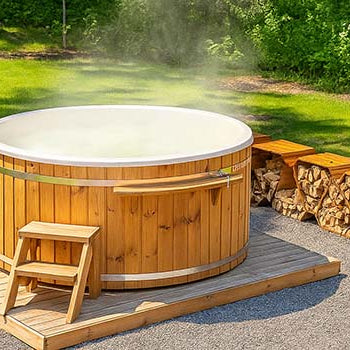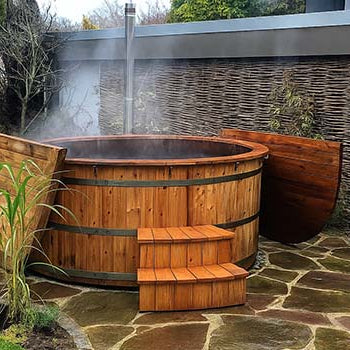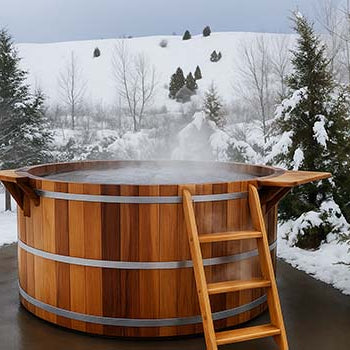Want hot tub bliss without the shocking bill? Solar heating is the cheapest way to warm your tub, and yes, even your Acrylic, Rotomoulded, or charming Wooden one. Curious how sunlight, insulation hacks, and clever tech can save you a fortune? Keep reading, we're heating things the smart way.

The Basics of Hot Tub Heating Costs
Energy Needed to Heat Water vs. Energy Lost to Surroundings
Here’s the thing: heating water takes energy, but keeping it warm is the real cost trap.
Once you’ve hit that perfect 38°C, any heat lost to the outside means your system kicks back in to make up for it.
In short, you’re paying for the heat you lose, not just the heat you use.
That’s why energy-efficient heating isn’t just about what warms the water, it’s about what stops it from escaping.
Think of it like trying to keep a mug of tea warm in a windy garden.
Key Factors Influencing Heat Loss (Insulation, Cover, Climate)
A poor-quality cover or a draughty spa shell is like leaving your oven door open.
Heat vanishes fast without proper insulation, especially in colder UK climates.
The weather, the wind, and even the position of your tub all make a difference.
A south-facing spot with a solid thermal lid? That’s a win.
Add in base insulation and side panel foam, and you’ll lock in heat much better.
Comparing Heating Methods Based on Running Cost
Standard Electric Resistance Heaters: The Common Baseline
If your hot tub came with a plug-and-play setup, chances are it has an electric heater.
These are reliable but pricey to run.
Electricity in the UK hovers around £0.34 per kWh, which adds up if you use your tub often.
They’re convenient, sure, but not built for savings.
If you want lower bills, it’s time to look at smarter alternatives.
Air Source Heat Pumps (ASHP): Lowest Cost Electric Heating Option
These clever systems grab warmth from the air and transfer it to your hot tub water.
They use far less energy than a traditional heater, often cutting running costs by up to 70%.
Popular with Rotomoulded Hot Tubs and premium models alike, they’re efficient and long-lasting.
Even in chilly weather, they still get the job done with surprising speed.
This is where tech meets savings.
Wood Fired Stoves: Dependent on Firewood Cost and Availability
Got a Wooden Hot Tub and a log pile in the garden? You’re in luck.
Wood burners can be ultra-affordable if you’ve got cheap or free firewood.
You’ll need to light it manually and manage the flame, but the cost-per-soak can be tiny.
It’s ideal for countryside homes or rustic retreats.
Plus, there’s something magical about soaking in fire-heated water under the stars.
Gas Heaters: Less Common in UK Domestic Settings, Variable Fuel Costs
Gas heaters warm up water quickly, making them common in commercial spas.
But for UK homes, they’re less popular due to installation requirements and rising gas prices.
Fuel cost depends heavily on your supplier, so it’s hit or miss.
Unless your home’s already set up for it, electric or wood tends to be simpler.
Gas is fast, but not always cheap.
Solar Thermal Systems: Supplementary Heating, Weather Dependent
Sunlight is free. But in the UK? Not always dependable.
Solar panels or thermal mats can reduce costs during warmer months.
They're best used as a helper, not a primary heat source.
A solar cover, though, is a must; it traps free heat and slows down loss overnight.
Just don’t count on it when it’s grey and rainy.

Why Air Source Heat Pumps Offer Major Savings
Understanding Heat Pump Efficiency (Coefficient of Performance - COP)
Air Source Heat Pumps (ASHPs) don’t generate heat, they transfer it, which makes them far more efficient than traditional electric heaters. This efficiency is measured by the Coefficient of Performance (COP).
For example, a unit with a COP of 4 produces 4 units of heat for every 1 unit of electricity used. That’s not just efficient, it’s remarkably cost-effective. It’s like paying for a small heater but getting the output of a much larger one.
For frequent hot tub users, ASHPs are a smart long-term investment.
Potential Savings on UK Electricity Bills
Switching from a standard electric heater to an ASHP can cut your hot tub’s running costs by up to 50%.
This isn’t just marketing hype, you’ll see the difference on your energy bills. Over the course of a year, that could mean hundreds of pounds saved.
For households who use their hot tub regularly, the payback starts quickly. It’s a no-brainer for anyone looking to lower their energy footprint.
Initial Investment Considerations and Payback Time
ASHPs do come with an upfront cost, typically between £1,000 and £2,500 installed. But this is an investment that pays for itself, often within 1 to 3 years, depending on usage.
After that, you’re simply enjoying reduced heating costs every day. Think of it as an upgrade to your comfort and savings in one go.
Evaluating Wood Fired Heating Costs
Cost of Purchasing Seasoned Firewood vs. Self-Sourcing
Buying seasoned firewood for your hot tub usually costs £80–£100 per cubic metre. But if you have access to your own supply, self-sourcing firewood can make heating nearly free.
Just be sure to use properly seasoned logs, they burn hotter, cleaner, and safer. Green or fresh wood will produce smoke, poor heat, and frustration.
Time and Effort Involved in Fire Management
Wood-fired heating is hands-on. You’ll need to build the fire, monitor it, and wait for the water to reach temperature. For some, it’s a relaxing ritual. For others, it’s a time-consuming task.
If your schedule is tight, this may not be the most convenient option.
Efficiency comes with effort.
Adhering to UK Smoke Control Area Regulations
If you live in a UK smoke control zone, it’s crucial to ensure your stove is DEFRA-approved.
Using a non-compliant burner could lead to fines or enforcement action.
Check with your local council to make sure your setup is legal and safe.
Making Your Existing Electric Heater Cheaper to Run
Maximising Your Hot Tub's Insulation
Insulation is your first defence against energy waste. Focus on the cabinet and base, where most heat escapes.
Add foam board insulation or thermal blankets to improve heat retention. The result? Your heater runs less frequently, saving energy every day.
A better-insulated tub = lower running costs.
Using a High-Quality Thermal Cover Consistently
A thick, well-fitting thermal cover can prevent up to 80% of heat loss.
Leaving your tub uncovered, even for a short while, lets precious heat escape.
Treat your cover like a non-negotiable part of your setup, it’s an easy way to save from day one.
Leveraging Off-Peak Electricity Tariffs If Available
If you're on a plan like Economy 7, you can take advantage of cheaper nighttime rates.
Simply set your hot tub timer to heat and filter during off-peak hours.
A small change in schedule can lead to big savings.
Setting an Optimal, Consistent Water Temperature
Running your tub at 40°C might feel luxurious, but it’s also costly. Instead, aim for a steady 36–38°C.
Avoid turning the heater off and on frequently, maintaining a consistent temperature is more energy-efficient.
Find a comfortable setting and stick to it.
Ensuring Filters are Clean for Efficient Water Flow
Clogged filters reduce heating efficiency by restricting water flow.
Rinse your filters weekly, and give them a deep clean monthly.
It’s a quick task that helps your heater work faster and your water stay clearer.
Clean filters = better performance and lower energy bills.

Conclusion: ASHPs are Cheapest for Electric Heating; Wood Fired Viable with Cheap Fuel
So, what’s the smartest way to heat your hot tub without boiling your budget?
Air Source Heat Pumps win for electric systems, hands down. They’re efficient, low-cost, and perfect for regular use.
But if you’ve got free logs and a love for fire, wood fired tubs can be surprisingly affordable.
Throw in good insulation, a solid cover, and clever habits, and you’ll enjoy hot soaks all year, without the guilt of a rising energy bill.
Spa time just got smarter.








